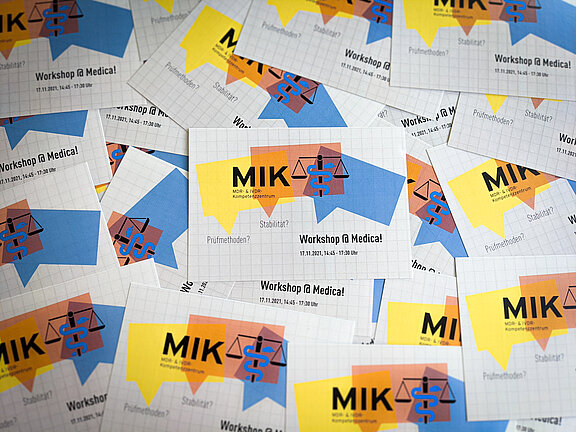
Workshops
MIK-WEBINAR: "PFAS - Can medical devices still be produced without them?"
26.4.2023
Per- and polyfluorinated alkyl substances, PFAS for short: They are the focus of a restriction procedure by ECHA. This could have significant consequences for medical technology, in terms of products but also manufacturing processes. An update on this will be provided by an online event on April 26, 2023.
PFAS are extremely stable compounds. They cannot be degraded naturally, accumulate in the environment and can thus become a health risk for humans. For this reason, ECHA is aiming to completely ban this extensive group of substances in the longer term. This has several consequences for medical technology. On the one hand, medical products containing PFAS are threatened with extinction, as no substitute substance with the same properties is yet available. Secondly, companies whose products are actually PFAS-free may also be affected: PFASs can also be found in auxiliary and operating materials or as a component of production equipment. If they are no longer allowed to be used in these areas, this would have far-reaching effects on manufacturing in general.
A free online information event on April 26 will address these topics in more detail. Joint organizers are Med Alliance BW, the state-wide expert initiative for the implementation of regulatory requirements, and MIK - MDR & IVDR Competence Center. Medical Mountains GmbH will first shed light on the current status and the further course of the restriction procedure. An industry example will be used to illustrate in which medical devices and where in production PFAS are used and how the restriction is handled. The NMI Natural and Medical Sciences Institute at the University of Tübingen shows possibilities to replace PFAS and addresses the need for development in terms of materials and analytics.
Clinical trial for medical devices
26.4.2023
Are you planning to conduct a clinical trial, but are unsure what and what effort is required? What do you have to take into account? How do you avoid escalating costs?
Answers to these and other questions are offered in this newly designed event format with workshop character by the MDR & IVDR Competence Center MIK.
In the full-day workshop, you will actively train how to plan a clinical trial using exemplary cases. Based on short impulses and the support of experts, you will develop the study concept for a model product in a small group. In addition, support tools for conducting a clinical trial will be presented, which you can try out directly. Afterwards, you will have the opportunity to present your results to the other participants and receive feedback.
In this way, you not only receive structured information, but also actively put knowledge into practice!
Better together - industry and clinic
05/2022
Presentations and discussions on the following topics:
- Existing offers on clinical data in Baden-Württemberg (BIOPRO).
- Needs assessment in the context of the MDR & IVDR competence center (NMI)
- Clinical interaction using the example of a development project in medical technology (NMI)
- Offers of the Center for Clinical Studies (ZKS Tübingen)
- Workshop phase
MIK workshop "CoCr- use or replace?"
07.04.2022
In dental applications, for example, cobalt is an essential component in a number of medical devices and is used primarily in cobalt-chromium alloys. In addition, cobalt is contained as an alloying component or impurity in many stainless steels used in medical technology and also in materials such as titanium. The new Medical Device Regulation (MDR) sets strict guidelines for the use of so-called CMR substances (carcinogenic, mutagenic and/or toxic for reproduction) in medical devices. Under the CLP Regulation, cobalt is assessed as a CMR substance (specifically, cobalt is harmonized classification as carcinogenic Cat. 1B, mutagenic Cat. 2, toxic to reproduction Cat. 1B) and, according to the MDR, may only be present in concentrations greater than 0.1 percent by mass "if there is specific justification for the presence of these substances" (MDR EU 2017/745 10.4.2). When this case exists, which product classes and in what way they are affected, is often difficult for manufacturers to identify and was the topic of our workshop "Insert or replace?". Cobalt alloys in medical technology" on April 7, 2022.
Initial situation and state of the art
Official justification is required for the use of CMR substances such as cobalt above the permitted limit concentration. This can be done by estimating the potential exposure of patients and users based on literature data and experimental measurement of the release kinetics, as well as an analysis of possible alternative substances and a justification of the corresponding rejection. The statement on cobalt in dental alloys developed by the German Dental Industry Association (VDDI) can serve as a basis for argumentation (https://www.fide-online.org/downloads/Cobalt_in_Dentallegierungen-Langfassung_2021-06-08.pdf) are used. The presence of these substances must be indicated on the product or on the outer packaging.
"Cobalt-containing materials will continue to be irreplaceable in medical technology in every case" (Dagmar Martin).
Possible strategy in the company
For the initial preparation of a CMR assessment for a specific medical device, a structured approach is advantageous (see scheme). A detailed comparison of the product portfolio with regard to cobalt use is necessary, whereby attention must be paid here to both the starting materials used and the finished medical device. The next step is the preparation of a risk-benefit analysis. If a product change does not appear to be sensible for justified reasons, an adjustment of the IFU and the labels used is necessary, as well as the transfer of the data to Eudamed.
Conclusion
Should the manufacturer come to the justified conclusion in his CMR assessment that the use of possible substitutes of cobalt are inappropriate in the context of maintaining the functionality, performance, and risk-benefit ratio of the product, a detailed justification must be included in the technical documentation. The Notified Body may then take this into account in the assessment and, depending on the individual case, grant approval of products with cobalt concentrations above 0.1% by mass.
MIK Workshop "Test Methods and Stability Testing under the MDR & IVDR"
19.01.2022
The interactive workshop "Test Methods and Stability Testing under the MDR & IVDR" offered not only interesting presentations but also space for questions and discussions.
Dr. Natascha Verhagen presented the demand-oriented support for medical technology companies - the Immediate Assistance Program. Among other things, topics such as literature evaluation, particle exposure of medical devices, quality assurance agreement and PMS/PMCF/PMPF were dealt with and prepared, for example, in documents. In the future, a database will help users find the right location for clinical studies. In addition to these practical aids, the immediate help offers the possibility of exchange, e.g. within the MDR & IVDR Treffs BW.
Die Soforthilfe is sponsored by the Ministry of Economy, Labor and Tourism.
Insights into the IVDR
Dr. Sophie Bartsch (Johner Institut GmbH) and Fred Obrath (Hahn-Schickard-Gesellschaft für angewandte Forschung e.V.) gave in-depth insights into the requirements of test methods and stability testing of the IVDR. What is the regulatory framework? What does the IVDR require? What are the main changes to the IVDD (e.g. in the post-market process)?
"According to the EU IVDR Regulation, there is no grandfathering: previous products lose their approval and have to be reassessed for conformity. In the workshop, it became clear that the comprehensive performance assessment for in vitro diagnostics is a major challenge for smaller medical technology companies, not only from an organizational point of view, but especially with regard to the many technical inspection procedures and tests. This is where we come in, because we offer stability testing at our company." (Fred Obrath)
In a further step, the stability testing process and its structure were addressed; in the meantime, tests for the stated shelf life, shelf life after breakage and transport stability are required, which must be documented in a stability study plan and a stability study report.
MIK partner Hahn-Schickard provides the appropriate infrastructure for these tests, e.g. for real-time reagent storage and accelerated aging tests.
Insights into the MDR
Christoph Kiesselbach (Schrack & Partner) and Dr. Dagmar Martin (NMI) provided insights into aging and degradation testing of medical devices. What is the legal framework and the corresponding requirements? Information such as this can be found in the essential safety and performance requirements, among others. A reasonable implementation of the requirements is possible based on the benefit-risk ratio of the product. In principle, the state of the art must be taken into account, which is summarized, for example, by the MDCG, common specifications and (harmonized) standards.
"Knowledge of their production processes is the key to MDR. Stable medical devices result from stable, validated production processes"(Dr. Dagmar Martin).
An essential factor in medical devices is aging, which is determined by various parameters during manufacture, transport, storage and use. Important for the test planning is the consideration of the chemical and toxicological properties as well as an extensive literature research. In addition, risk assessment and post-marketing surveillance must be considered.
You can find the whole lecture here.
For this purpose, the MIK partner NMI offers test methods for degradation & degradation, chemical characterization, accelerated and real-time aging, as well as measurement and evaluation of extractables and leachables.





